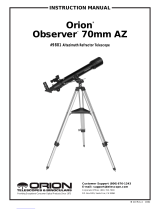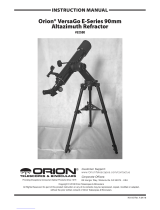
8
center an object in the eyepiece for viewing. Tension on both
axes is set at the factory, but if you feel some further tweaking
is warranted, read on.
Tension in the altitude axis is adjusted by turning the large
tension adjustment knob (Figure 3) to be tighter or looser.
To adjust the tension of the azimuth axis you will rst need
to remove the photo tripod adapter (Figure 6). Simply loosen
and remove the three Phillips-head screws on the adapter,
and it will lift right off. Then you must use two 13mm or adjust-
able wrenches (not included), one on each nut, as shown
in Figure 11, to tighten or loosen them as needed to adjust
the amount of friction. Once you have made the necessary
adjustments, reinstall the adapter with the three Phillips-head
screws.
Focusing the Telescope
The TableTop telescopes both come equipped with an adjust-
able focuser designed to keep images sharp. The SkyScanner
100 Reector has a 1.25” rack-and-pinion focuser with two
large manual focusing knobs (Figure 5A). The StarMax 90
Mak-Cass has a single focus knob on the back end of the
tube assembly (Figure 5B).
We recommend practicing focusing in the daytime when start-
ing out to get the hang of it. With the 20mm eyepiece insert-
ed into the focuser, aim the optical tube so the front (open)
end is pointing in the general direction of an object at least
1/4-mile away. With your ngers, slowly rotate the focus knob
until the object comes into sharp focus. Go a little bit beyond
sharp focus until the image starts to blur again, then reverse
the rotation of the knob gradually, until you’ve nailed the exact
focus point.
IV. Using Your Telescope
Choosing an Observing Site
When selecting a location for observing, get as far away as
possible from direct articial light such as street lights, porch
lights, and automobile headlights. The glare from these lights
will greatly impair your dark-adapted night vision. Avoid view-
ing over rooftops and chimneys, as they often have warm air
currents rising from them. Similarly, avoid observing from
indoors through an open (or closed) window, because the
temperature difference between the indoor and outdoor air
will cause image blurring and distortion.
If at all possible, escape the light-polluted city sky and head
for darker country skies. You’ll be amazed at how many more
stars and deep-sky objects are visible in a dark sky!
Cooling the Telescope
All optical instruments need time to reach “thermal equilibri-
um.” The bigger the instrument and the larger the temperature
change, the more time is needed. Allow at least 20 minutes
for your telescope to acclimate to the temperature outdoors
before you start observing with it.
Let Your Eyes Dark-Adapt
Don’t expect to go from a lighted house into the darkness of
the outdoors at night and immediately see faint nebulas, gal-
axies, and star clusters—or even very many stars, for that mat-
ter. Your eyes take about 30 minutes to reach perhaps 80% of
their full dark-adapted sensitivity. As your eyes become dark-
adapted, more stars will glimmer into view and you’ll be able
to see fainter details in objects you view in your telescope.
To see what you’re doing in the darkness, use a red-ltered
ashlight rather than a white light. Red light does not spoil
your eyes’ dark adaptation like white light does. A ashlight
with a red LED light is ideal. Beware, too, that nearby porch
lights, street lights, and car headlights will ruin your night
vision.
“Seeing” and Transparency
Atmospheric conditions vary signicantly from night to night.
“Seeing” refers to the steadiness of the Earth’s atmosphere at
a given time. In conditions of poor seeing, atmospheric turbu-
lence causes objects viewed through the telescope to “boil.”
If you look up at the sky and stars are twinkling noticeably,
the seeing is poor and you will be limited to viewing at lower
magnications. At higher magnications, images will not focus
clearly. Fine details on the planets and Moon will likely not be
visible.
In conditions of good seeing, star twinkling is minimal and
images appear steady in the eyepiece. Seeing is best over-
head, worst at the horizon. Also, seeing generally gets better
after midnight, when much of the heat absorbed by the Earth
during the day has radiated off into space.
Especially important for observing faint objects is good
“transparency” – air free of moisture, smoke, and dust. All
tend to scatter light, which reduces an object’s brightness.
Transparency is judged by the magnitude of the faintest stars
you can see with the unaided eye (6th magnitude or fainter is
desirable). If you cannot see stars of magnitude 3.5 or dim-
mer then conditions are poor. Magnitude is a measure of how
bright a star is – the brighter a star is, the lower its magnitude
will be. A good star to remember for this is Megrez (mag. 3.4),
which is the star in the “Big Dipper” connecting the handle
to the “dipper”. If you cannot see Megrez, then you have fog,
haze, clouds, smog, or other conditions that are hindering
your viewing. (See Figure 12.)
Tracking Celestial Objects
The Earth is constantly rotating about its polar axis, complet-
ing one full rotation every 24 hours; this is what denes a “day”.
We do not feel the Earth rotating, but we see it at night from
the apparent movement of stars from east to west. When you
observe any astronomical object, you are watching a moving
target. This means the telescope’s position must be continu-
ously adjusted over time to keep a celestial object in the eld
of view. This is called “tracking” the object. It’s easy to do with
the TableTop telescopes because of their smooth motions on
both axes. As the object moves off towards the edge of the
eyepiece’s eld of view, just lightly nudge or tug the telescope
to re-center the object. Objects appear to move across the



















